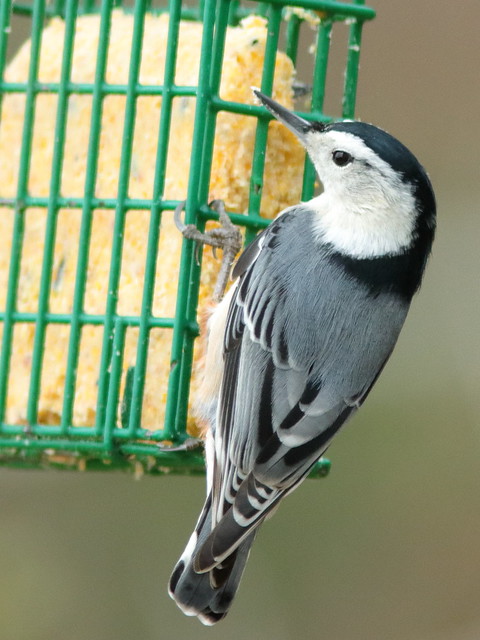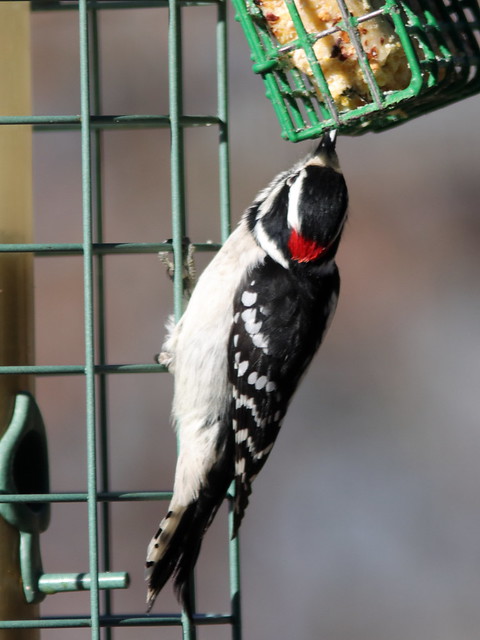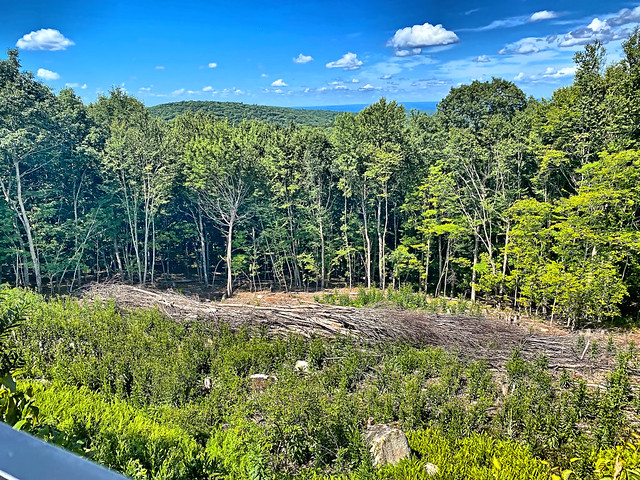We moved to Connecticut from south Florida this past January, but I have not yet adapted to the cold and windy winter weather. Although winter is more than three weeks away, November overnight temperatures have been down into the low 20's °F (-6 °C) with gray skies and gusting winds.
Morning walks are out of the question. As our home is high on a granite bluff, we feel the full force of the prevailing northwest winter winds. Often the conditions improve to permit an afternoon stroll through the lower elevations in our neighborhood where the wind is usually more moderate.
Therefore, most of my photography has been through the glass windows in our "front door" which commands a good view of the bird feeders. Even though I keep the inside and outside glass as clean as possible, the double panes greatly reduce the clarity of my photos, especially if shooting at an angle rather than directly through the panes.
Only a few bird species are visiting, a far cry from winter in Florida, where we could easily log 20 species on a causal walk in the local Wounded Wetlands.
Now our most common feeder birds are non-migratory Tufted Titmice:
Black-capped Chickadees are mostly permanent residents, though the species may migrate locally in response to food availability. They are nearly as common as the titmice. Here a chickadee shares the suet feeder with a male House Sparrow:
White-breasted Nuthatches increased in numbers during late summer into autumn. This species is present year-round, though there may be occasional irruptive migration from far northern populations. More likely, we are seeing many local juvenile birds:
Note the nuthatch's upturned bill, an adaptation to its "upside-down" foraging behavior:
All three of these species have the habit of collecting a single sunflower seed and taking it to a perch where it is held in its feet and pried open, or in the case of nuthatches, secured on the bark of a large branch and hacked apart. This nuthatch is just dropping a sunflower seed:
Woodpeckers spend much time at the suet cake, though they often take seeds from the tube feeder. These are male and female Downy Woodpeckers:
Note the placement of this male's red head patch, on the back of its head (occiput):
This similar but considerably larger Hairy Woodpecker has a different pattern to its red head spot. While it is located on the top of the head or even in front of the eyes in juvenile birds, it is more to the back of its head in adults. Most of my other photos of male Hairy Woodpeckers showed the single red spot to be occipital, as in this male I photographed in New Mexico in 2008:
Yet my Connecticut bird exhibited two red spots on his head. I thought this may have been an individual variation, but according to Birds of the World, "East of Rocky Mountains, red ends on the side of the head, creating a red patch on each side, separated by black of variable width on the nape."
Their difference in size is evident when the Hairy Woodpecker visits the suet feeder. The Hairy also lacks the black bars on its outer tail feathers, characteristics of the Downy Woodpecker. It also has a prominent white eye ring, a variable trait not common in Downy:
Dark-eyed Juncos generally do not take seed from the tube feeder. Rather, they forage for scattered seeds under and on the granite shelf nearby:
House Finches are relatively abundant all year 'round. This male exhibits colorful plumage:
This male American Goldfinch is in winter plumage:
Normally common, Northern Cardinals have been relatively scarce in recent weeks, but lately a pair has appeared. This is the male:
Now that the leaves have fallen, we have a view of the lake from our front yard:
I captured a record of the advance of autumn. These photos were taken from my perch along the fence at the top of this rock wall. The roof of our home is barely visible:
August 19, 2022-- The clear-cut area is almost entirely carpeted by Sow Thistle which produces seed and down (pappus), to the delight of scores of goldfinches which nest in the surrounding trees:
October 7, 2022-- The stalks of Sow Thistle have now dried up, but their spreading roots will persist and extend the patch in the spring. (That's my shadow from top of cliff):
October 23, 2022-- Autumn color is developing:
October 26, 2022-- Peak autumn color:
October 28, 2022-- Brown foliage is overtaking the scene:
October 31, 2022-- The understory is increasingly visible:
November 6, 2022-- All the leaves are gone!:
= = = = = = = = = = = = = = = =
My Corner of the World
________________________________________________
Please visit the links to all these posts to see some excellent photos on display
________________________________________________




























What a wonderful autumn...like here, in Romania. In order to see birds it is necessary to become a part of the silence.:)
ReplyDeleteStunning Fall landscapes, Ken. The cardinal and woodpeckers are the easy ones, because they are so visible. Have a happy Thanksgiving with your family!
ReplyDeleteGuess my comment didn't come through... stunning Fall landscapes! The woodpecker and red cardinal are easy because they're so easy. Have a happy Thanksgiving with your family:)
ReplyDeleteI guess that I should wash my windows to get better views of the feeders and the birds that use them. You get such great photos through the glass.
ReplyDeleteI love your sequence of the woods as time passed.
Beautiful shots.
ReplyDeleteYour autumn photos are gorgeous! The birds are charming, of course.
ReplyDeleteYour views are absolutely beyond fantastic. Trees with color and then trees completely barren of leaves ... you have a lot of elbow room where you live. I will start looking closer at the woodpeckers around here to see if they have one spot or two spots.
ReplyDeleteI like the way you have documented the change in the seasons.
ReplyDeleteYou are a good friend to the birds. Brrrr!
ReplyDeleteI know I couldn't take harsh, cold, winters any more. But your window treatments are perfect Ken.
ReplyDeleteThanks. You made my day today; sharing your photos and narration with linking in!!
You have great views from inside your home. A funny name - titmouse. My grandmother moved to a street named titmouse when I was a child. I thought it was a dirty name and couldn't understand how adults named it that.
ReplyDelete@Carol-- You remind me of a recent exchange in response to a reply on the Next Door app--
DeleteME: Male and female Northern Cardinals form a strong pair bond and remain together all year long. While divorce does occur, they usually mate for life and seek a new partner only after death of a previous one...
COMMENT: how do i know if they are divorced? Do they hang out in seedy bars?
ME: No, they only visit respectable places like Mingle at the Millet snd Sunflower Saloon. The marriage ended after she caught him at the Bawdy Birdbath with a tawdry titmouse.
I've never seen red marking on the back of our woodpeckers' heads - interesting! I would have thought this was an odd variant, too.
ReplyDeleteTHANKS for sharing at https://image-in-ing.blogspot.com/2022/11/i-love-seasons-of-year.html
What fab autmnic captures love those close ups :-)
ReplyDeleteHave a feedertastic week 👍
Beautiful pictures of birds.
ReplyDelete,,,you attract some beautiful birds, I seem to attract squirrels.
ReplyDeleteThanks for sharing your feeder birds, Ken! Would love to see a White-breasted Nuthatch and some juncos stop by down here!
ReplyDeleteSimply lovely views all around.
I do love you have such a colourful array of birds, and such varity. I have to laugh that you moved FROM Florida - isn't the joke that you move TO Florida with age? Hopefully you get your winter weather tolerance soon....Thanks for joining #Allseasons - same post will be for next week's link up as I'm watching the soccer not writing. So feel free to swing by to link a second post next week.
ReplyDeleteStunning foliage! I’d like to see one of those woodpeckers with the red dots.
ReplyDeleteAwesome creatures!
ReplyDeleteThanks for sharing your link at My Corner of the World this week!
The birds are quite wonderful (and I wish my photos taken outside were half as good as yours taken through glass). Autumn is a lovely season -- one good reason to be "up North".
ReplyDeleteI always look forward to your post for show of stunning bird captures. The capture of transition of Autumn weather is marvelous . Thanks for sharing with Garden affair.
ReplyDelete